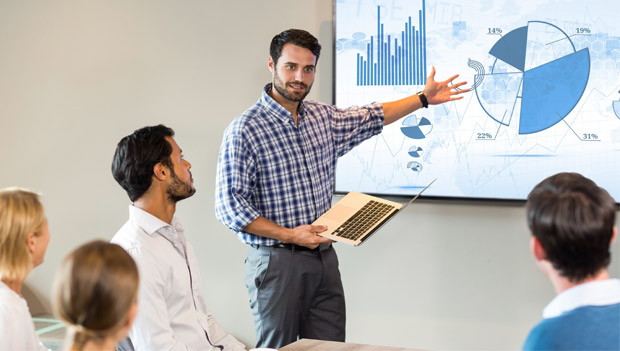Best visual aids for presentations
Making it easier for everyone to understand a presentation, visual aids can be used at a meeting to maintain interest.
When used properly, they will enhance proceedings but if used badly, they can have the opposite effect and detract from the point you’re aiming to put across.
If you’re planning to use visual aids, it’s important to prepare in advance to ensure you can operate them efficiently, as nothing loses delegates’ interest faster than seeing the speaker fumbling about with technology and struggling to make it work.

Ranging from the simple flip chart to software such as PowerPoint, there are a number of common visual aids – each with their own advantages.
Whiteboards
As one of the most popular visual tools, the whiteboard is good for recording interaction and comments during a brainstorming session, for drawing diagrams and for developing an explanation. When using a whiteboard, ensure your writing is large enough and legible so that everyone can read it. Remember, it takes time to write on a whiteboard and you will also be turning your back on your audience for a short time.
Flip chart
A flip chart is a low tech, low cost option which is useful for recording brainstorming sessions and interactive meetings. Portable, it can be prepared in advance and it doesn’t require a power source or technical expertise. Flip charts can be used to collect responses and ideas from the audience and they are useful for a spontaneous summary of the meeting.
Video
A video is an ideal training aid and when a computer is connected to a projector, videos can be played from a DVD, from files or from online sources if the meeting room has an internet connection. You can also build a video into a presentation using software such as PowerPoint.
PowerPoint
PowerPoint (and similar presentation software) is among the most common visual aid. The potential benefits include increasing visual impact, improving audience focus, enriching the curriculum and increasing interactivity. If using PowerPoint, always have a practice run in advance to ensure you are confident and efficient when giving the presentation.
Overhead projector
Although one of the older visual aids, an overhead projector can still be effective, as material in both written and graphic forms can be prepared in advance on acetates. It is suitable for groups of all sizes, although it’s important to talk to the audience rather than becoming distracted and talking to the screen. Good quality slides can have an impact on any presentation, but you won’t be able to add spontaneous notes.
Handouts
Software such as PowerPoint can generate handouts from presentation slides. It’s important to know when to distribute handouts: in general, don’t hand them out at the start of the meeting, as the attendees may start reading them, rather than listening to the speaker. Handouts are useful if your presentation contains complex charts or graphs, as in this case, attendees will appreciate receiving a handout before the meeting begins. They can also make their own notes on the printed handout.
Use visual aids if you feel they’re necessary to maintain interest and assist your audience to understand your presentation, but don’t use them simply as a means to demonstrate your technical competence. Remember, even the simplest visual aids can enhance any meeting if used in the correct way.
&Meetings can ensure you always have the best venue for your meeting – and we can provide you with your visual display essentials! For meeting rooms in London, please call 0800 073 0499 and we’ll be happy to help you through the booking process.
Share this post
Tags
- Career Development
- Celebrity Meetings
- Conferences
- Confidence
- Exhibitions
- Historic Meetings
- How to Interview Effectively
- Human Resources
- In The Press
- Meetings and Conferences
- Monarchy
- News
- Our Team
- Personal Development
- Personnel
- Presentation Techniques
- Teamwork
- Top Tips for Meetings
- Training & Workshops
- Video Conferences



